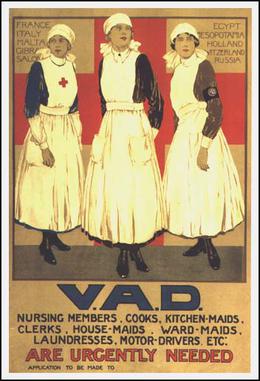|




















visit DP&G Publications site to purchase
books >>

Nursing
The Voluntary Aid Detachment (VAD) was a voluntary organisation
providing auxiliary nursing services, mainly in hospitals, in the
United Kingdom and various other countries in the
British Empire. The organisation's most important period of operation was
during
World War I and
World
War II.
The organisation was founded in
1909 with the help
of the
Red Cross and
Order of St. John. By the summer of 1914 there were over 2,500 Voluntary Aid
Detachments in Britain. Each individual volunteer was called a detachment, or
simply a VAD. Of the 74,000 VADs in 1914, two-thirds were women and girls.
At the outbreak of the First World War, nurses were in short supply, and the
VAD supplemented the work of
registered nurses. Although generally looked down upon by more highly
trained nursing staff , they nonetheless provided an invaluable source of aid as
war nurses to the
war effort.
Katharine Furse took two VADs to France soon after the outbreak of the
First World War. She established a hospital at Boulogne and returned to
London where she became Commander-in-Chief of the organisation. During the next
four years 38,000 VADs worked as assistant nurses, ambulance drivers and cooks.
VAD hospitals were also opened in most large towns in Britain.
Before 1915 the military authorities would not accept VADs at the front-line.
This restriction was later removed and women volunteers over the age of
twenty-three and with more than three months experience, were allowed to go to
the Western Front, Mesopotamia and Gallipoli. Later VADs were also sent to the
Eastern Front.
Some women acted as letter writers for soldiers who were either too ill or
too illiterate to write their own letters.
In 1909 the Voluntary Aid Detachments were formed to provide nursing and
medical assistance during wars. two Thirds of VAD's were women and girls.



|